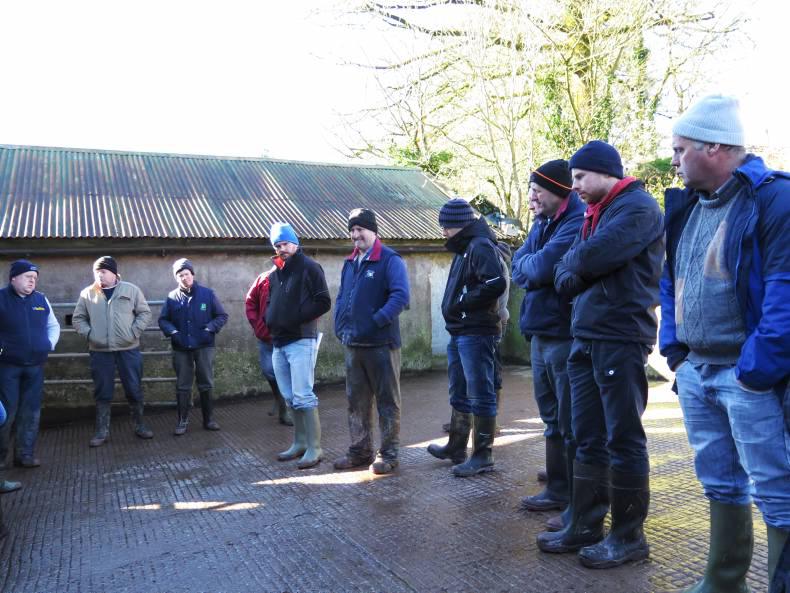Late last week and early this week, the Irish Farmers Journal travelled to two discussion groups in west Cork to see how the spring is progressing as calving is in full flow.
Both groups of spring-calving herds were about one third of the way through calving. Every farmer had the milking cows out grazing, with most out day and night as grazing conditions are perfect. Here we highlight the key messages at the farm walks.
Opening farm cover for the groups was 960kg DM/ha, which is over 100kg more than had been predicted in their grass budgets. Higher than planned opening covers appear to be commonplace nationwide as overwinter growth was greater than anticipated and farmers generally closed at higher covers due to a mild November. So with lots of grass available and weather conditions close to perfect, there was a good mood in the air.
Higher covers
Every farmer had paddocks with very high grass covers of between 1,800 and 2,200kg DM/ha. However, most were grazing lighter covers of less than 1,000kg to start off with because it was felt that freshly calved cows wouldn’t have the same vigour or appetite to graze out the heavy swards.
Most farmers also felt that, if grazed, the higher grass covers would grow very little grass after grazing because the grass would be a yellow/brown colour at the base and would take a long time to recover.
This was deemed important as the paddocks grazed in February are the paddocks grazed first in the second rotation, so they need to recover quickly.
Other farmers were grazing out the lower covers to increase the percentage of the farm grazed. Normally, the target for farmers in the southern half of the country is to have 30% of the farm grazed by 1 March. With later calving and later turnout further north, this is delayed by one to two weeks.
Percentage grazed
Some members of the west Cork groups were planning to graze significantly more area this February – between 40% and 50% of the farm. These farms have limited or no quota available for the spring so they do not want to feed meal to milking cows if at all possible and as a result will graze more area than normal in February.
There is a big risk in grazing over 30% in February that there may not be enough grass to stretch the first rotation until the end of March.
Having a higher average farm cover than planned now will help to reduce that risk, but heavy feeding (4kg to 5kg of meal and maybe silage) may be required in late March and April if growth rates are low in March.
According to Teagasc researcher Brian McCarthy, the critical figure at the start of the second rotation is average farm cover, and this should not drop below 450kg DM/ha.
“If average farm cover drops below 450kg, pre-grazing yields will be less than 1,000kg which is too low as cows will be working harder for their fill of grass and regrowths will suffer.”
Obviously, a lot will depend on the weather and its effect on grass growth between now and 1 April but farmers who are grazing more than 30% in February need to be aware that heavy feeding could be required to bridge a feed gap between demand and growth in the second rotation.
Maiden heifers out
Most farmers in both groups were letting out maiden heifers this week to increase the area grazed.
The lower stocked farmers were questioning whether they should let out dry cows to graze off some of the higher covers, especially swards with a higher proportion of dead and decaying material.
The feeling was that some of these higher covers are stagnating and at least if they were grazed they would be back in the growing phase earlier rather than if they are left until March to be grazed.
Condition score
Another issue that came up was the condition score of dry cows, with many farmers in the group disappointed with the condition of their cows. Because a significant number of the cattle been milked once a day prior to early dry-off, many farmers felt that cows should be in better condition than they are at present.
Certainly, some cows are calving down in condition score less than the target of 3.25. The group decided that there is very little that can be done to improve this now other than putting these cows on once-a-day milking after calving, which will slow down the rate of condition score loss post-calving.
Effectively, it is too late to manage this problem now with feed but if cows were condition scored at drying off and again during the winter, it would help to identify problem cows earlier. These cows could then be given preferential treatment – either better quality silage or meal.
Soil samples
Some group members had received soil sample results from samples taken in the autumn and were going about formulating a fertilizer plan for the year. Obviously, Index 1 and Index 2 fields should be targeted first for slurry, and chemical phosphorus and potassium applications. The message from both groups when formulating a plan is that it is important to look at the soil mg/l level for each nutrient as there is a wide range within each index and target fields at the lower end of the scale.






 This is a subscriber-only article
This is a subscriber-only article












SHARING OPTIONS: